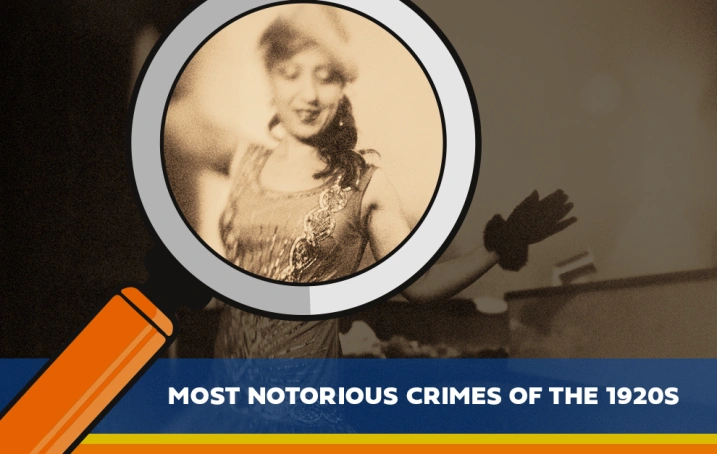The Roaring Twenties was a decade that saw unprecedented economic growth, wealth, and exuberant celebrations–but underneath the surface lurked organized crime and violence. The 18th Amendment's ratification initiated Prohibition which spawned bootlegging operations run by notorious mobsters. This period of time also witnessed some of the most infamous trials and murders in 20th-century history. Here are some of the most notorious crimes of the 1920s:
The Leopold and Loeb Murders
In 1924, University of Chicago students Nathan Leopold and Richard Loeb kidnapped and murdered Bobby Frank in May 1924. The trial of Leopold and Loeb created a frenzy of conversation throughout Chicago, as these two affluent men were accused of murdering Bobby Frank merely for the "thrill."
Leopold and Loeb sent an extortion letter to Bobby Frank’s father via typewriter, stating they would return his son for $10,000. The criminals lured Bobby into their rental car and then struck him with a chisel. After disposing of all evidence–including the bloody clothes–Leopold and Loeb believed themselves invincible in committing this heinous murder.
After the police discovered a pair of eyeglasses near Bobby's body, they determined that the glasses had been sold at one shop in Chicago; it just so happened that out of three people who bought them, Leopold was one. This incriminating evidence connected him and his friend to the murder.
Leopold and Loeb, who admitted guilt in the kidnapping case and were given 99 years of imprisonment as well as life sentence for murder. Unfortunately, Loeb passed away at 30 while in jail due to a fatal jab from another inmate in 1936; whereas Leopold acquired parole after 33 long years of incarceration and eventually died of heart attack at 66 in 1971.
The St. Valentine's Day Massacre
Perhaps the most famous of all mob-related incidents, The St. Valentine's Day Massacre took place on February 14th 1929 in Chicago. A group of 7 members from Al Capone's gang dressed up as police officers and entered a warehouse belonging to George ‘Bugs’ Moran's gang and shot him down, along with six other members of his gang. The reason behind the attack is still unknown to this day although it was believed that Capone's men were after Bugs Moran in an attempt to gain control of Chicago’s illegal liquor trade.
The St. Valentine's Day Massacre further established Al Capone as one of the most powerful mobsters in the country. Although Capone was never convicted for this murder due to a lack of evidence, he was eventually imprisoned for tax evasion and other charges.
The Lindbergh Kidnapping
In 1932, American aviator Charles Lindbergh's 20-month-old son, Charles Jr., was kidnapped from his bedroom in their New Jersey home. After a ransom of $50,000 had been paid, the baby was found dead two months later–setting off one of the most notorious manhunts in U.S. history.
The search for Charles Jr.'s murderer ensued and ultimately led to Bruno Richard Hauptmann's arrest in 1934. After a sensational trial, Hauptmann was found guilty and sentenced to death by electric chair–the first-ever execution of its kind.
The Lindbergh kidnapping remains one of the most famous unsolved cases in U.S. history. The tragedy prompted Congress to pass the "Lindbergh Law" which made kidnapping a federal crime and led to the Department of Justice creating the Federal Bureau of Investigation (FBI).
Albert Fish: Notorious Serial Killer
Albert Fish was one of the most notorious serial killers of the 1920s. From 1924 to 1934, he is suspected of having killed seven children in New York City and its surrounding areas. He was finally arrested after a letter he wrote to one of his victims' families revealed information that only their killer would know.
At trial, Fish plead guilty to the horrible crimes he had committed and was sentenced to death by electric chair. He showed no remorse for his actions, even telling the jury that "I always had a desire to injure little children."
The case of Albert Fish is one of the most notorious in U.S. history, as it brought attention to the dangers of child predators and the need for more stringent laws to protect the safety of children. Fish's gruesome acts highlighted how important it is to have a justice system that can catch and punish such monsters.
The Santa Claus Bank Robbery
On December 23, 1927, an odd incident took place in Cisco, Texas. A man dressed as Santa Claus entered a bank and staged a robbery - the first ever "Santa Claus Bank Robbery". Five men were involved in the crime and they managed to steal over $30,000 from the bank.
The investigation ultimately led to four of the five criminals being arrested and sentenced to prison. The fifth member of the gang, Harvey Bailey, was never caught; however, he is believed to have died in 1969 while on the run from the law.
To this day, the Santa Claus Bank Robbery is seen as one of the most daring robberies ever attempted and serves as an example of the lengths criminals will go to in order to get their hands on some quick cash.
Find 1920s Crimes and Mysteries Entertaining? Watch One Unfold Before You!
The Semgulf Murder Mystery Dinner Train is proud to present a brand new, original Murder Mystery dinner show. Set in the 1920s, childhood friends, now mobsters, find themselves in a precarious situation as they clash with each other and the women they love. Showing now through 3/05/2023. Get your tickets today!

